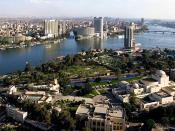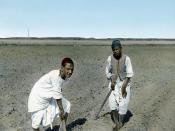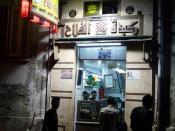EGYPT : The people
Approximately 32,500,000 people live in Egypt. Peasant farmers called fellahin make up over 60 percent of the population. But less than 4 percent of Egypt's land is suitable for farming. Before the leaders of the 1952 revolution introduced land reform, less than 2 percent of the landowners owned half of the land available for farming. Most of the fellahin were tenants or owned very tiny farms. A man who owned 3 to 5 acres was considered well-off. Now no one is permitted to own more than 50 acres, and the average Egyptian farm is generally much smaller than that.
An Egyptian farmer's main tools are the hoe, a simple plow, and the sakia, or waterwheel. The fellah, his wife, and their children all work together in the fields. The dreary routine of their lives is relieved only on a few occasions-the group prayer in the mosques on Fridays, religious feasts, and family events such as weddings or the circumcisions of young boys.
A farmer's most valuable possession is the water buffalo, cow, or ox that helps him with the heavy farm work. The water buffalo or ox draws the plow, turns the waterwheel, and pulls the nowraj. The nowraj is a wooden platform mounted on four or five iron disks. The sharpened edges of the disks crush the stalks of wheat so that the grain can be separated from the chaff. The water buffalo or cow also supplies the fellah's family with milk and with calves that can be sold. Very often the fellah shares his house with his animals. This is unsanitary, but it is the farmer's preferred way of protecting them. The theft of an animal could mean economic catastrophe for the poor fellah.
The fellah wears a loose, long cotton robe called a...



Need work
Some of the ideas are great using example but others lack support.
4 out of 4 people found this comment useful.